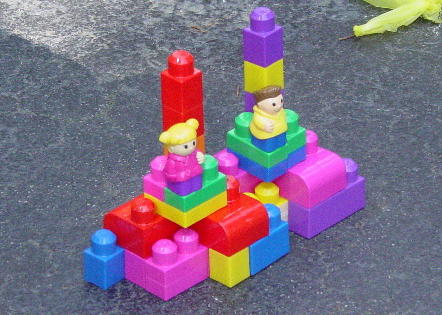How Observant Are Both You and Other People?
Blocking Communication is a game that is designed to test communication skills and the ability to describe strange objects.

Objective
To create a Lego® figure identical to the shape the rest of your teammates have
Materials
- Players
- Legos
- Check Points that are marked for each team
- Timer/Stopwatch
- Whistle (Optional)
Procedure
Preassemble Lego structures into as many teams as you plan on having, such as 3. Make sure all of these preassembled structures look the same, except for coloring. You can use different size blocks to achieve the same shape, as long as it looks similar in the end (e.g. 2 single-height blocks instead of 1 double-height block), although you can choose not to.
Players are divided into teams of as close to equal players as possible. The teams are then again divided in half giving each original team a Team A and a Team B. For example, if you started out with 3 teams, after the teams are split again, you will have Team 1A, Team 1B, Team 2A, Team 2B, Team 3A and finally Team 3B.
Now all of the team As should stay on one side of the playing field and all the team Bs stand at the other side where they can't see the As. To start out, each team A is given a different figure made out of legos.
Meanwhile, each team B is given a set of separate legos that can form the figure their corresponding team has (Team 1A and Team 1B). Between where the A's and B's are located, check points are set up. These check points can be set up using traffic cones or such, and one of each is labeled with a team name (Team 1, 2, 3).
Each Team A and Team B designates a runner for each round of the game. When round one begins, an instructor, standing in a central area (such as the check points), blows the whistle or calls out for the first runner. The first runners from every team run to the check point and meet with the other member from there team (Ex: first runner from 2A and 2B meet).
When the players meet, the player from team A tries to describe their figure to the player from team B and relays whatever other additional information they think is necessary. The players have 45 seconds to communicate the features of the figure. After the 45 seconds the team members go back to their teammates and relay what they learned. The build team works as a group to try and replicate the structure just described. The describing team tries to gauge how well the other side understood them and what they should tell them at the next run.
There should be at least 3 runs, depending on how many people are in each group (more people --> more runs). After the number of runs is complete, all the groups should come together and compare structures. If you decide to play again, play with a different structure and reverse the team roles (build team now becomes description, description team now becomes the build team)
Conclusion
After this activity, explain to the students how the activity demonstrates the importance of effective communication and observation skills. More than likely, a couple of teams will have designs that are drastically different from the actual design. Point these out if you need an example of how one side can easily get confused or doesn't hear what they need to hear.